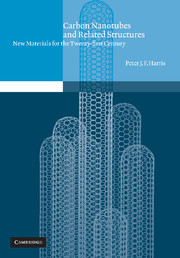Book contents
- Frontmatter
- Contents
- Acknowledgements
- 1 Introduction
- 2 Synthesis: Preparation methods, growth mechanisms and processing techniques
- 3 Structure
- 4 The physics of nanotubes
- 5 Nanocapsules and nanotest-tubes
- 6 The ultimate carbon fibre? The mechanical properties of carbon nanotubes
- 7 Curved crystals, inorganic fullerenes and nanorods
- 8 Carbon onions and spheroidal carbon
- 9 Future directions
- Name index
- Subject index
8 - Carbon onions and spheroidal carbon
Published online by Cambridge University Press: 28 January 2010
- Frontmatter
- Contents
- Acknowledgements
- 1 Introduction
- 2 Synthesis: Preparation methods, growth mechanisms and processing techniques
- 3 Structure
- 4 The physics of nanotubes
- 5 Nanocapsules and nanotest-tubes
- 6 The ultimate carbon fibre? The mechanical properties of carbon nanotubes
- 7 Curved crystals, inorganic fullerenes and nanorods
- 8 Carbon onions and spheroidal carbon
- 9 Future directions
- Name index
- Subject index
Summary
Nevertheless, the most interesting question is whether, 500 years
after Columbus reached the West Indies, flat carbon has gone the
way of the flat Earth.
Harry Kroto, Nature, 22 October 1992When one browses through the carbon literature, spheroidal forms of carbon crop up again and again. Examples include carbon black, mesophase pitch and the graphitic particles in spherulitic graphite cast iron, all of which constitute technologically important materials. Despite many years of research, however, the structure and formation of these particles remains inadequately understood. Prior to the discovery of the fullerenes, models of spheroidal carbon particles had tended to involve assemblies of flat graphene fragments, which seems inherently unsatisfactory. The discovery of C provides us with a new paradigm for spheroidal carbon, and the time seems ripe to take a fresh look at spheroidal carbon in all its forms.This chapter will consider the evidence that fullerene-like elements may be present in the wellknown forms of spheroidal carbon mentioned above. though, a discussion is given of the most recently discovered form of spheroidal carbon: carbon onions.
Carbon onions
Discovery
The synthesis of carbon onions in 1992, like so many discoveries in fullerene science, was serendipitous.The Brazilian electron microscopist Daniel Ugarte, working at the Ecole Polytechnique Fédérale de Lausanne in Switzerland, had been examining carbon nanoparticles filled with gold and with lanthanum oxide, and decided to investigate the effect of electron irradiation on these structures (8.1). In the case of the encapsulated gold clusters, the irradiation caused the gold to be expelled from the carbon nanoparticle, while at the same time inducing a change in the nanoparticle's structure from faceted to rounded.
- Type
- Chapter
- Information
- Carbon Nanotubes and Related StructuresNew Materials for the Twenty-first Century, pp. 235 - 265Publisher: Cambridge University PressPrint publication year: 1999



